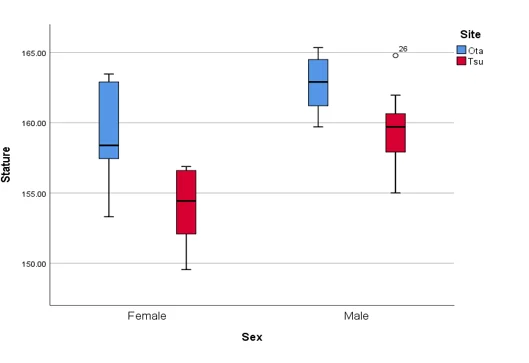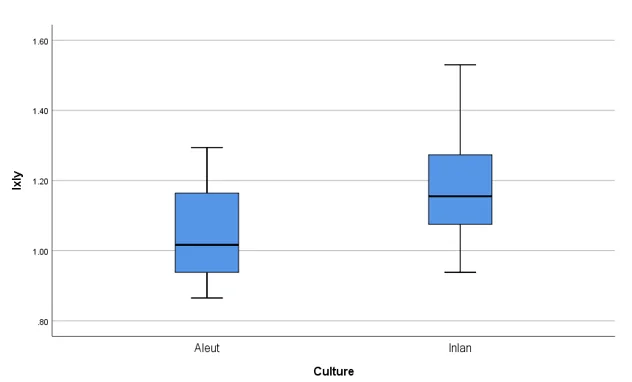Problem Description:
In this data analysis assignment, we delve into the anthropometric characteristics of two distinct populations, exploring both female stature and humeral shape. The primary focus is on understanding the variations between different sites and communities, shedding light on potential differences in habitual activities or genetic influences.
Part I: Female Stature Analysis
A. Boxplot:

Chart 1: Male and female stature analysis
The boxplots depict the non-normal distribution of male and female stature at two different sites, Ota and Tsukumo. Unequal whisker lengths and non-symmetrical box divisions indicate this non-normality. Notably, there is no overlap between medians and interquartile ranges, both within each site and between Ota and Tsukumo.
B. Summary Statistics:
Female Stature (Ota):
- Mean: 155.6365
- Std. Deviation: 3.85339
- Variance: 14.849
- Skewness: 0.640
- Kurtosis: 0.196
Female Stature (Tsukumo):
- Mean: 160.7938
- Std. Deviation: 2.83127
- Variance: 8.016
- Skewness: -0.224
- Kurtosis: -0.419
C. Independent Sample t-test:
Female Stature (Ota vs. Tsukumo):
- Equal Variances Assumed: p = 0.009
- Null Hypothesis: Variances are the same (Not Rejected)
- Null Hypothesis: No difference between groups (Rejected)
Male Stature (Ota vs. Tsukumo):
- Equal Variances Assumed: p = 0.001
- Null Hypothesis: Variances are the same (Not Rejected)
- Null Hypothesis: No difference between groups (Rejected)
Conclusion (Female Stature):
- Female stature variances are assumed equal.
- Significant differences exist between Ota and Tsukumo females.
- Similar conclusions for male stature with equal variances assumed.
Part II: Female Humeral Shape Analysis
Boxplot:

Chart 2: The female Humeral shape analysis
The boxplots illustrate the non-normal distribution of the female humeral shape for Aleutian Island and Inland/Riverine hunter-gatherers. Unequal whisker lengths and non-symmetrical box divisions suggest non-normality. Overlapping interquartile ranges and medians indicate potential acceptance of the null hypothesis of no difference.
Mann-Whitney U Test Summary:
- Total N: 47
- Mann-Whitney U: 373.500
- Test Statistic: 373.500
- Standardized Test Statistic: 2.818
- Asymptotic Sig.: 0.005
Conclusion (Female Humeral Shape):
- Null hypothesis rejected.
- Significant difference in median humeral shapes for Aleutian Island and Inland/Riverine hunter-gatherers.
- Implies differences in humeral shape variation and habitual activity between the two communities.